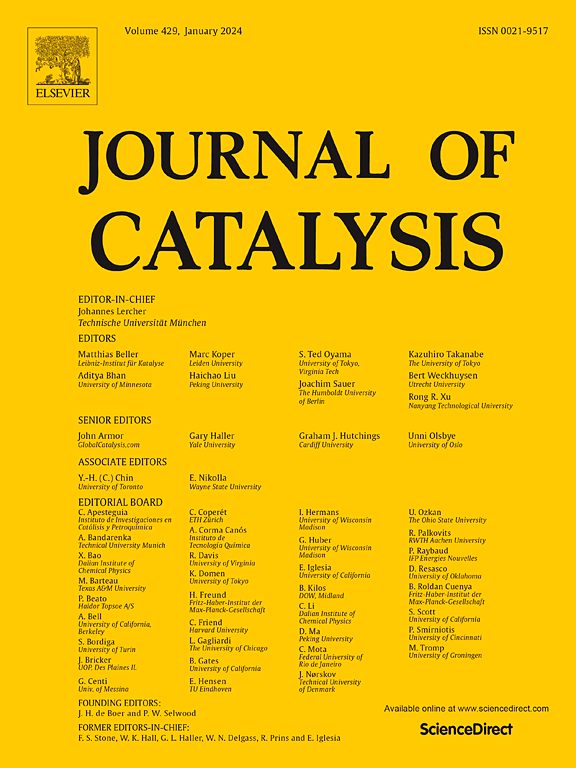光等离子体接力催化分子氧活化
IF 6.5
1区 化学
Q2 CHEMISTRY, PHYSICAL
引用次数: 0
摘要
清洁能源驱动的分子氧活化(MOA)对于绿色氧化技术和可持续化学的发展至关重要。虽然光催化和等离子体催化一直被认为是有前途的MOA绿色手段,但这两个过程如何结合起来,以超越各自高效MOA的能力,在很大程度上仍未被探索。本研究以氧化物悬浮液为介质,将光催化与溶液等离子体催化耦合,阐明光等离子体催化MOA的具体接力机制。在所测试的各种氧化物中,锐钛矿-金红石混合组成的TiO2光催化-溶液等离子体协同效果最好,双酚A的氧化分解速率分别比光催化和等离子体催化高11.3倍和5.6倍。溶液等离子体与UV激发协同作用,提高了金红石型TiO2上·O2 -的产率和锐钛矿型TiO2上·O2 -向1O2的转化,从而促进了锐钛矿-金红石界面上的继电MOA。我们对MOA的接力机理和异质结界面促进协同作用的发现,为清洁能源驱动的异质结材料催化反应开辟了新的途径。本文章由计算机程序翻译,如有差异,请以英文原文为准。


Photo-plasma relay catalysis for molecular oxygen activation
Clean energy driven molecular oxygen activation (MOA) is crucial for the advancement of green oxidation technology and sustainable chemistry. While photocatalysis and plasma catalysis have long been regarded as promising green means for MOA, it remains largely unexplored by which mechanism these two processes can be combined to surpass the capability of each individually for efficient MOA. In this study, we couple photocatalysis with solution plasma catalysis by using oxides suspensions as the mediator, and elucidate the specific relay mechanism of photo-plasma catalysis for MOA. Among the various oxides tested, TiO2 with an anatase–rutile mixed composition performs the best for photocatalysis-solution plasma synergy, resulting in 11.3 times and 5.6 times higher rate of oxidative decomposition of bisphenol A than that of photocatalysis and plasma catalysis alone, respectively. The solution plasma in synergy with UV excitation boosts the yield of ·O2– on rutile TiO2 and the conversion of ·O2– to 1O2 on anatase TiO2, thereby promoting a relay MOA at the anatase–rutile interface. Our findings on the relay mechanism of MOA and the promotion of synergy by the heterojunction interface open new avenues for clean energy driven catalytic reaction with heterojunction materials.
求助全文
通过发布文献求助,成功后即可免费获取论文全文。
去求助
来源期刊

Journal of Catalysis
工程技术-工程:化工
CiteScore
12.30
自引率
5.50%
发文量
447
审稿时长
31 days
期刊介绍:
The Journal of Catalysis publishes scholarly articles on both heterogeneous and homogeneous catalysis, covering a wide range of chemical transformations. These include various types of catalysis, such as those mediated by photons, plasmons, and electrons. The focus of the studies is to understand the relationship between catalytic function and the underlying chemical properties of surfaces and metal complexes.
The articles in the journal offer innovative concepts and explore the synthesis and kinetics of inorganic solids and homogeneous complexes. Furthermore, they discuss spectroscopic techniques for characterizing catalysts, investigate the interaction of probes and reacting species with catalysts, and employ theoretical methods.
The research presented in the journal should have direct relevance to the field of catalytic processes, addressing either fundamental aspects or applications of catalysis.
 求助内容:
求助内容: 应助结果提醒方式:
应助结果提醒方式:


